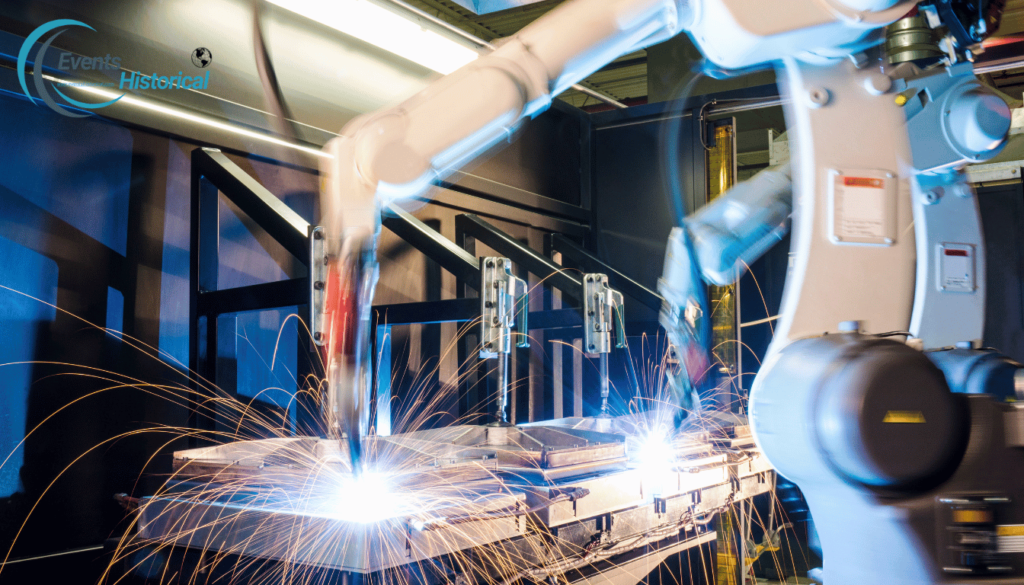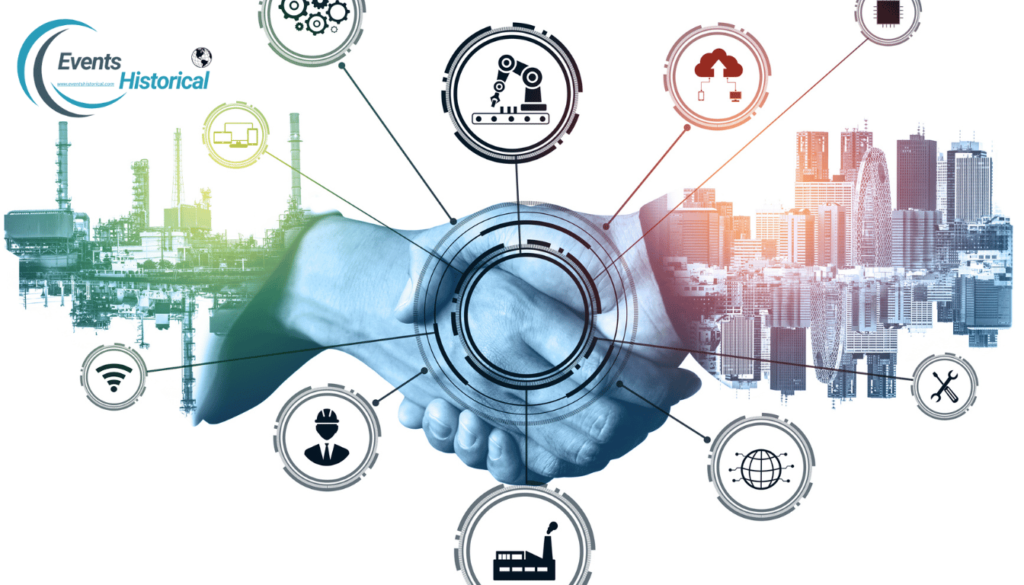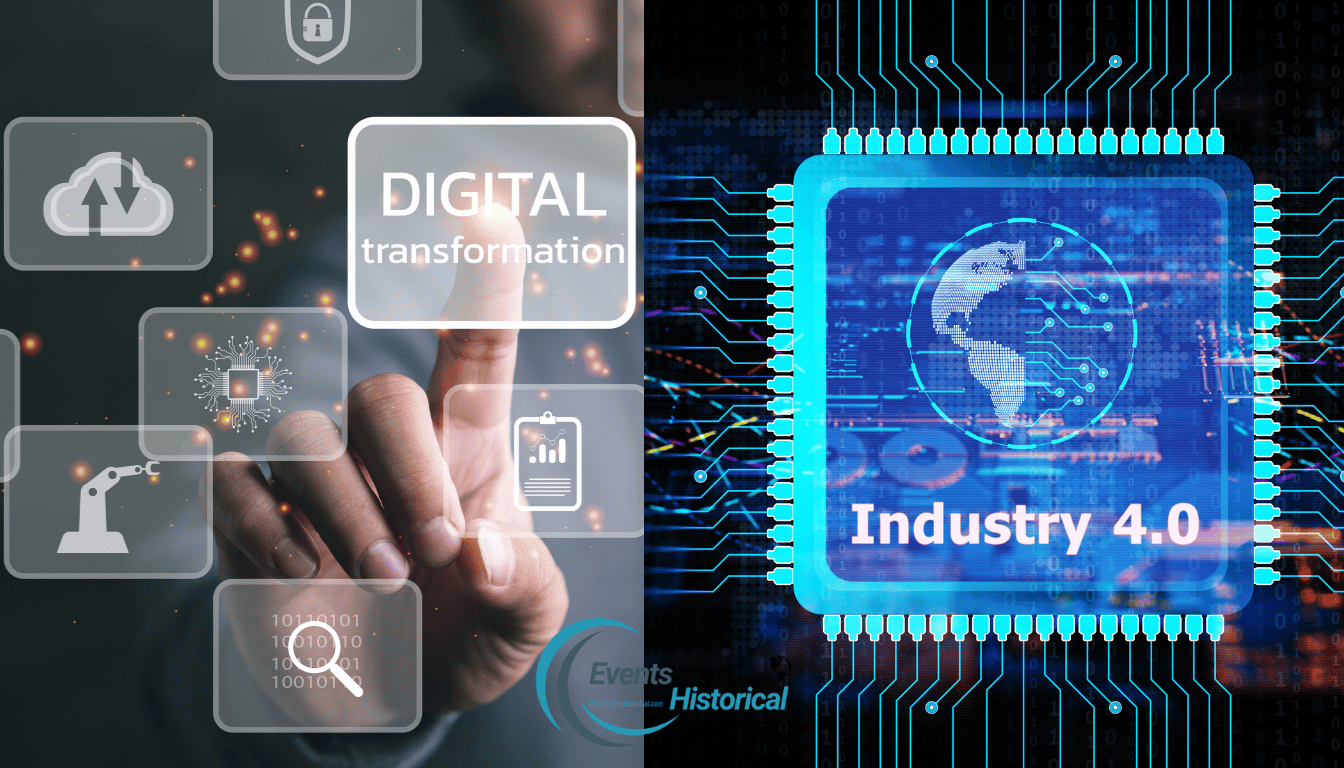Discuss shift to manufacturing then to technology in the Rise of the Digital Industrial Economy- 1990s- Present and its effect on industries.
Let me picture where manufacturing is seen not only as the large building with machinery and assembly line but. It was not about what digital technologies are and how they are integrated into a person’s work life. The Digital Industrial Economy is a pretty immense shift from the more traditional manufacturing to industries heavily focused on technology. But it explains how organisations employ new technologies such as artificial intelligence and big data to work smarter and more sustainably.
This shift is fast and changing the game. It’s key to see how industries keep up in a world going digital fast.

Key Takeaways
- The Digital Industrial Economy integrates digital technologies with industrial processes.
- Technological innovations are crucial for enhancing productivity and competitiveness.
- Artificial intelligence and big data play significant roles in manufacturing technology transformation.
- Understanding market structure and economic performance is essential for navigating this transition.
- Investment in green and smart industrial chains is on the rise due to the digital economy.
- Innovation drives change, resulting in a more sustainable and efficient industrial landscape.
The Rise of the Digital Industrial Economy (1990s-Present): From Manufacturing to Tech
The shift from making things to using technology has shaped our economy since the 1990s. Companies have used new tech to meet global needs and improve customer service. The internet started in 1990, helping businesses change how they work.
By 2022, digital changes cost $1.6 trillion. Experts think this number could hit $3.4 trillion by 2026. This shows how big the digital shift is.
The iPhone changed everything from 2007 to 2019. The term “Digital Transformation” came up in 2013. It showed how important it was to update old ways.
The COVID-19 pandemic made online shopping and supply chains even more important. This helped businesses become more flexible and efficient.
Now, we’re in the era of generative AI, starting in 2022. Tools like ChatGPT from OpenAI have made work easier. It quickly got 1 million users, showing how fast new tech is adopted.
In 2023, Meta and Amazon made big steps in AI. This shows we’re still moving towards a tech-driven future.

This change from old ways to new tech is ongoing. It’s key for businesses to keep growing and innovating.
This paper focuses on comprehending the key of the Digital Industrial Revolution.
The digital industrial revolution is changing the manufacturing world. It combines advanced technologies to update old processes. This change shows how technology is affecting manufacturing in many fields.
Technologies like artificial intelligence and robotics make work more efficient. They change how companies do business. Smart technology, like machine-to-machine communication, is also changing how goods are made and delivered. These changes help companies be more flexible and make products that fit what customers want.
Businesses are now better at using resources and finding new ways to make money. They use advanced data and connectivity to make smarter choices. This lets them work in new ways without losing control or quality.

Countries need to understand and use these new technologies to stay ahead. Adopting the digital industrial revolution helps companies stay strong in a fast-changing world. It makes them ready for new economic challenges.
| Technology | Description | Impact on Manufacturing |
|---|---|---|
| Artificial Intelligence | Simulating human intelligence processes by machines | Increased efficiency in decision-making and operations |
| Internet of Things | Interconnecting everyday physical devices to the internet | Enhanced connectivity and real-time data collection |
| Advanced Robotics | Robots that can perform complex tasks autonomously | Reduction in manual labor and increased precision |
| Cloud Computing | Internet-based computing that provides shared resources | Scalability in data management and access |
The digital industrial revolution is changing how industries work, innovate, and succeed today.
Key Technologies Driving the Digital Transformation
As industries try to stay ahead, it’s key to know the main technologies driving change. Artificial intelligence, big data, and the Internet of Things (IoT) in manufacturing are at the forefront. Each one helps make operations more efficient and improves decision-making.
Artificial Intelligence and Machine Learning
AI and machine learning are big players in digital transformation. They help with predictive analytics, giving insights from past data. This makes manufacturing better by automating tasks and making decisions smarter.
Companies can guess what the market wants, cut downtime, and make products better. All thanks to smart systems.
Big Data and Cloud Computing
Big data and cloud computing are the heart of modern manufacturing. They handle the huge amounts of data we get every day. This data is key to understanding market trends and what customers want.
Cloud solutions offer the power to analyze data fast. This helps companies make better strategies in today’s fast world.
Internet of Things (IoT) in Manufacturing
The IoT has turned old factories into smart ones with connected devices. These devices watch over equipment and production lines in real-time. This leads to better efficiency and less waste.
IoT lets machines and systems talk to each other smoothly. This gives valuable data that boosts productivity and insights.
Impact of Technology on Manufacturing Processes
Technology has a big impact on how things are made. It changes old ways of making things, making them better and more efficient. With new tech like robots and AI, people can focus on more important tasks.
Using advanced analytics helps make products better and manage stock better. Companies can make quick decisions with real-time data. This makes them more productive and always getting better.
Companies that use new tech are seen as leaders. They can keep up with what customers want. As tech gets better, it will help make things even faster and better.
Industry 4.0 Revolution and Its Implications
The Industry 4.0 revolution is changing manufacturing in big ways. It brings smart factories and advanced automation to the forefront. This era is all about connectivity, thanks to cyber-physical systems. These systems make it easy for machines, systems, and humans to work together, leading to better production.
Smart Factories and Automation
Smart factories are changing how we make things. They use new tech to make production faster and more efficient. Some key features of smart factories include:
- Real-time monitoring of production systems for better decision-making.
- Predictive maintenance that spots problems before they happen.
- Autonomous logistics that adjust to changes in production needs.
By using these smart technologies, companies can make their products better and faster. This shows the huge potential of the Industry 4.0 revolution.
Cyber-Physical Systems and Connectivity
Cyber-physical systems are the heart of smart factories. They connect different parts of a manufacturing setup. These systems allow for:
- Smooth data sharing across all production steps.
- Better teamwork between industrial robots and human workers.
- Flexibility in sharing information to support flexible work environments.
This leads to a more efficient and sustainable manufacturing world. Understanding these changes is key for companies wanting to use new tech in their work.
Economic Growth Through Technology Integration
Technology is key to economic growth, especially in manufacturing. Companies that use new tech become more productive. They also find new ways to grow and create jobs.
As they move to tech-based processes, they open up many opportunities. This creates a rich environment for growth.
Job Creation in Tech-Driven Manufacturing
The need for skilled workers has increased with new tech. Jobs in manufacturing are changing. Now, there are roles in data analysis, robotics, and software development.
This change shows the need for training and upskilling. The workforce must adapt to the new industrial landscape.
- Increased roles in artificial intelligence and data analytics
- Demand for engineers focused on automation and robotics
- Skills required in digital logistics and supply chain management
Sustainability and Efficiency Improvements
Technology integration also leads to sustainability and efficiency. Companies using advanced methods can cut their carbon footprint. This helps them meet environmental rules and boosts their image with eco-aware consumers.
- Use of renewable energy sources
- Reduction of waste through lean manufacturing processes
- Optimization of resource utilization in production
Globalization and the Digital Economy
Globalization and the digital economy are changing how we do business worldwide. New technologies and better connections have made global supply chains more efficient. Now, companies can quickly respond to market changes and what customers want.
The Shift in Global Supply Chains
Global supply chains have changed a lot. International trade has grown a lot because of lower costs and better technology. Today, over 50% of global output is traded.
Exports have grown over 40 times since 1913. Businesses need to update their strategies to use these changes well.
Cross-Border Collaboration Initiatives
Cross-border projects are key for innovation and better resources. They help companies work together across borders, sharing knowledge and getting better market access. The digital economy makes it easier for companies to trade within industries.
By working together, businesses can reach more customers and grow. This is good for everyone involved.
| Aspect | Before 1800 | Post-1800 | Today |
|---|---|---|---|
| Trade Openness Index | Low | Significantly Increased | Around 25% of GDP |
| Intra-European Exports (% of GDP) | 1% | 10% | Growing |
| Exports to Asia from India | N/A | N/A | Above 30% |
Challenges and Risks in Digital Transformation
Organizations face many challenges in digital transformation. These include data security and adapting the workforce. Understanding both technology and human factors is key.
Data Security and Privacy Concerns
As businesses move online, keeping data safe is crucial. Digital operations bring many cybersecurity threats. It’s vital to protect against data breaches and keep customer trust.
Companies must create strong cybersecurity systems. These systems need to keep up with new threats.
Workforce Adaptability and Skills Gap
The digital world requires new skills that many employees don’t have. Traditional roles don’t fit the digital world. Employees must learn new skills to keep up.
This change makes training and recruitment hard. It’s important to invest in employee development. Training programs are key to helping employees succeed in a digital economy.
| Challenge | Description | Potential Solutions |
|---|---|---|
| Data Security | Risks associated with unauthorized access to sensitive information. | Invest in advanced cybersecurity measures and training. |
| Privacy Concerns | Challenges related to compliance with regulations like GDPR. | Implement strict data management policies and regular audits. |
| Workforce Skills Gap | Mismatch between existing employee skills and new technology needs. | Develop comprehensive training and upskilling programs. |
| Workforce Adaptability | Resistance to change in organizational culture and processes. | Promote a culture of continuous learning and flexibility. |
The Future of Work and Automation
The job world is changing fast because of automation and the move to a digital economy. This change makes us think about how different generations work together. Younger people, like Gen Y and Z, are bringing new skills to the table. Their tech savvy is helping shape the future of work.
Generational Workforce Changes
Younger workers are bringing fresh ideas and needs to the job market. They love technology and are ready for automation. Companies need to change how they work and think to fit this new generation.
It’s important for companies to train everyone to keep up with new tech. This helps create a workplace where everyone can work well together.
Emerging Roles in the Digital Economy
Automation is creating new jobs that fit the digital world. Jobs in data analysis, digital management, and advanced engineering are becoming more common. Companies need to learn more about these areas to stay ahead.
Here’s a table showing some of these new jobs, what they do, and what skills you need for them.
| Emerging Role | Responsibilities | Required Skills |
|---|---|---|
| Data Analyst | Analyze and interpret complex datasets to inform decision-making. | Statistical analysis, proficiency in data visualization software. |
| Digital Project Manager | Oversee digital projects from conception to execution. | Project management, agile methodologies, communication skills. |
| AI Specialist | Develop and manage artificial intelligence applications. | Programming, machine learning, data science. |
| Cybersecurity Analyst | Protect systems and networks from cyber threats. | Network security, risk analysis, problem-solving skills. |
| UX/UI Designer | Design intuitive user experiences for digital platforms. | Design software proficiency, user-centered design principles. |
Policy Recommendations for a Smooth Transition
Effective policies are key for a smooth shift to a digital economy. They help move from old manufacturing to new tech-driven ways. It’s important to invest in strong digital infrastructure. This is the foundation for these changes.
Investments in digital infrastructure boost connectivity and access for businesses. This helps them move into the digital world.
Workforce training is crucial to prepare employees for the digital shift. A skilled workforce boosts productivity and innovation. It’s also important to have data privacy rules that encourage creativity and progress. Finding the right balance between rules and innovation is essential for a strong economy.
- Encourage strategic partnerships between local development agencies and businesses to support community revitalization.
- Propose the establishment of an Advanced Research Projects Agency (ARPA) focused on hiring-friendly technologies.
- Expand industrial policy discussions to encompass service sectors and small to medium-sized firms.
- Implement collaborative approaches over traditional top-down policy instruments like subsidies.
- Address climate change issues through targeted subsidies for green technologies promoting decarbonization.
Working together between government, industry, and community groups is vital. This teamwork helps in a responsible digital transformation. It benefits businesses and strengthens the economy, making the transition smoother.
| Policies | Objectives | Expected Outcomes |
|---|---|---|
| Investment in Digital Infrastructure | Enhance connectivity and access | Increased business efficiency and innovation |
| Workforce Training Programs | Provide necessary digital skills | Improved labor market adaptability |
| Data Privacy Regulations | Protect user data | Foster consumer trust |
| Green Technology Subsidies | Address climate change | Support sustainable economic growth |
Conclusion
The shift from traditional manufacturing to a digital economy is a big change. It shows how important it is for companies to use new technologies and encourage innovation. This change helps make things more efficient, sustainable, and keeps them competitive globally.
Looking ahead, businesses need to make smart choices about technology and policies. The digital economy is growing fast, creating more jobs and better pay. For example, people working in the digital economy earn more than others, showing its value.
The future of manufacturing is all about being connected and using smart tech. To succeed, we need to be flexible, think ahead, and work together. This will help us fully benefit from the digital industrial economy.
FAQ
What is the Digital Industrial Economy?
The Digital Industrial Economy combines digital tech with industrial processes. It moves from old-school manufacturing to tech-based industries. This change boosts productivity, efficiency, and makes manufacturing more sustainable.
How has the digital industrial economy evolved since the 1990s?
Since the 1990s, big tech advancements have changed the digital industrial economy. Automation, AI, and data analytics have become key. These tools help companies work better and meet global needs.
What technologies are driving the digital transformation in manufacturing?
Artificial intelligence, big data, cloud computing, and IoT are leading the change. They help manage resources better, predict outcomes, and monitor operations in real-time.
What is Industry 4.0 and how does it impact manufacturing?
Industry 4.0 is the fourth industrial revolution, focusing on smart factories. It combines automation and cyber-physical systems. This boosts production efficiency and resource management, improving quality and speed.
How does technology contribute to economic growth in the digital industrial economy?
Technology drives economic growth by creating new jobs in tech-based manufacturing. It also makes production more sustainable and efficient. Companies that use technology can innovate and stay ahead in the market.
What challenges do companies face during digital transformation?
Companies face challenges like data security and privacy. They must deal with complex cyber threats. There’s also a need for adaptable workers to succeed in digital transitions.
How is globalization influencing the digital economy?
Globalization is changing supply chains into dynamic systems. Data analytics and connectivity make this possible. It helps companies adapt quickly to market changes and fosters global innovation and resource sharing.
What does the future of work look like in the context of automation?
Automation will change the future of work significantly. New roles will focus on data, engineering, and digital management. Companies must invest in training to prepare their workers for these changes.
Why are effective policy frameworks essential for the digital transition?
Good policies are key for digital growth. They support digital infrastructure, training, and data protection. Collaboration between government and industry is vital for a smooth transition.

